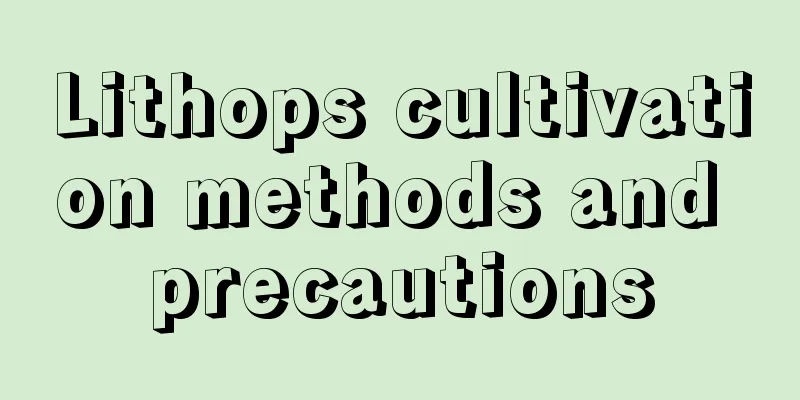When should garlic be watered for winter?

|
Garlic is grown in all parts of China, north and south. Generally speaking, garlic needs to be watered during the winter. Garlic has a shallow root system. After watering in winter, the soil has sufficient moisture, which can alleviate the huge changes in ground temperature and is conducive to the safe wintering of the garlic roots. So when should garlic be watered in winter? Let’s take a look with the editor below. 1. When should garlic be watered for winter? The best time to water garlic in winter is when the temperature reaches around 0℃ to 3℃, and the surface soil with an average ground temperature of around 5℃ in the 5cm soil layer melts during the day and freezes at night. It is generally appropriate to water it from "10 days before the winter solstice to 10 days after the winter solstice." Specifically, the time for watering during the winter should be chosen when the local average daily ground temperature is around 5°C, 3°C during the day and 0°C at night. Irrigation during this period can not only lay the foundation for the plants to turn green again, but also kill some garlic maggot eggs and reduce insect pests. At the same time, it should be noted that if the soil moisture and seedling conditions are poor, it is necessary to water the plants in advance. If the watering time is too late and the temperature is low, the water will freeze and cause frostbite on the roots. Therefore, the specific watering time needs to be determined according to local climatic conditions and the growth of garlic. When watering garlic during the winter, water it lightly with small amounts of water to keep the soil moist, and avoid flooding with large amounts of water that will cause water to accumulate on the ground and form an ice layer that will suffocate the roots. If there is enough base fertilizer, you can water the soil without watering. If there is insufficient base fertilizer, you can apply fully water-soluble quick-acting fertilizer along with the water. If the land is covered with plastic film, care should be taken to clean the loose soil on the film to help the garlic field fully absorb sunlight and store ground temperature. 2. Precautions 1. Weather selection: When watering during the winter, you should choose sunny weather after continuous night frost and daybreak. Under such weather conditions, the soil temperature is relatively stable, water is not easy to evaporate too quickly, and it can also reduce the stimulation to the garlic root system. 2. Watering time: Generally speaking, it is more suitable to water after 10 am and before 4 pm. If you water before 10 a.m., the soil temperature may not have risen yet, and the water will further lower the soil temperature, which is not conducive to the activity of the garlic roots; if you water after 4 p.m., as the temperature drops, the soil moisture evaporates slowly, which can easily cause the soil to be too humid. 3. Amount of watering: Water lightly with small amounts of water to keep the soil moist and avoid flooding with large amounts of water. It is advisable to water 20 to 30 cubic meters per acre of land, which can not only meet the garlic's demand for water but also will not damage the soil structure. 4. Ground film management: If the land is covered with ground film, care should be taken to clean the loose soil on the ground film to help the garlic field fully absorb sunlight and store ground temperature. The above is an introduction to when to water garlic for the winter. Garlic is generally watered for the winter in November. Pay attention to the watering time. If it is too late, it will aggravate the frost damage. The specific time can be determined according to soil moisture conditions and seedling growth. If the soil moisture is poor, water should be applied as early as possible.
|
<<: How to grow konjac to achieve high yield?
>>: How to grow sweet potatoes to achieve high yield?
Recommend
Cultivation methods and precautions of Brazilian iron tree
The Brazilian dracaena , also known as the Dracae...
Honeysuckle cutting method and time cutting propagation technology with high survival rate
Honeysuckle is a medicinal material that has the ...
The efficacy and function of Mirabilis jalapa root
1. It can reduce inflammation and relieve pain It...
What to do if Clematis is infected with white rot
Symptoms of Clematis Sclerotium The first time I ...
What should be paid attention to when cultivating and caring for the Weeping Guanyin in water? Advantages of hydroponics
1. What should I pay attention to when cultivatin...
When is the best time to repot a jade plant?
Jade plant is one of the most popular indoor foli...
How to plant lantern flower
1. Prepare materials Scissors, flower pots, shove...
How to prune beech trees
When to prune beech trees Beech trees should be p...
Cultivation methods and precautions of Areca palm
1. Breeding methods 1. Soil: When breeding, the s...
These common purple flowers are so beautiful!
Violet Violets are relatively cold-resistant but ...
How to prune pine red plum
When to prune pine red plum It is usually more ap...
Is Poinsettia Poisonous?
poisonous? Some experts believe that the entire p...
How to disinfect the soil
The role of soil in flowers Soil can stabilize pl...
How to promote new buds of tiger lily
Bottom Before we prepare the soil for it, we can ...
What is the value of bayberry
Medicinal value of bayberry Bayberry fruit is ric...









